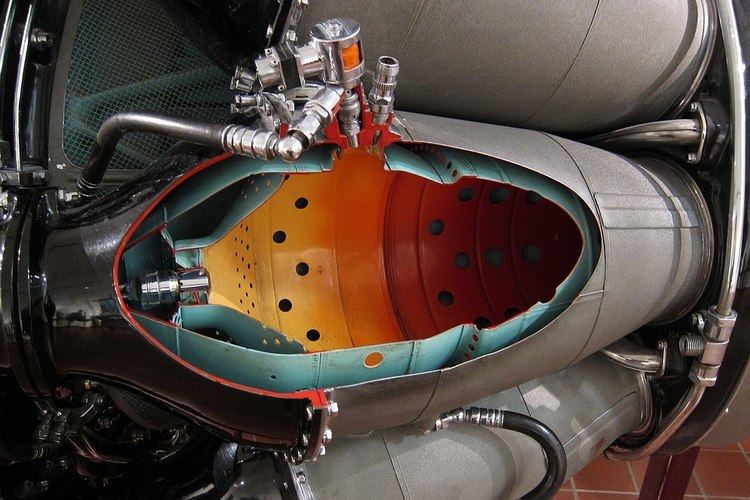 | ||
A combustion chamber is that part of an internal combustion engine (ICE) in which the fuel/air mix is burned.
Contents
Internal combustion engine
ICEs typically comprise reciprocating piston engines, rotary engines, gas turbines and jet turbines.
The combustion process increases the internal energy of a gas, which translates into an increase in temperature, pressure, or volume depending on the configuration. In an enclosure, for example the cylinder of a reciprocating engine, the volume is controlled and the combustion creates an increase in pressure. In a continuous flow system, for example a jet engine combustor, the pressure is controlled and the combustion creates an increase in volume. This increase in pressure or volume can be used to do work, for example, to move a piston on a crankshaft or a turbine disc in a gas turbine. If the gas velocity changes, thrust is produced, such as in the nozzle of a rocket engine.
Petrol (gasoline) engine
At top dead centre the pistons of a petrol engine are flush (or nearly flush) with the top of the cylinder block. The combustion chamber may be a recess either in the cylinder head, or in the top of the piston. A design with the combustion chamber in the piston is called a Heron head, where the head is machined flat but the pistons are dished. The Heron head has proved even more thermodynamically efficient than the hemispherical head. Intake valves permit the inflow of a fuel air mix; and exhaust valves allow burnt gases to be scavenged.
Various shapes of combustion chamber have been used, such as: L-head (or flathead) for side-valve engines; "bathtub", "hemispherical", and "wedge" for overhead valve engines; and "pent-roof" for engines having 3, 4 or 5 valves per cylinder. The shape of the chamber has a marked effect on power output, efficiency and emissions; the designer's objectives are to burn all of the mixture as completely as possible while avoiding excessive temperatures (which create NOx). This is best achieved with a compact rather than elongated chamber.
The intake valve/port is usually placed to give the mixture a pronounced "swirl" (the term is preferable to "turbulence", which implies movement without overall pattern) above the rising piston, improving mixing and combustion. The shape of the piston top also affects the amount of swirl. Another design feature to promote turbulence for good fuel/air mixing is "squish", where the fuel/air mix is "squished" at high pressure by the rising piston. Where swirl is particularly important, combustion chambers in the piston may be favoured.
Ignition typically occurs around 15 degrees before top dead centre. The spark plug must be sited so that the flame front can progress throughout the combustion chamber. Good design should avoid narrow crevices where stagnant "end gas" can become trapped, as this gas may detonate violently after the main charge, adding little useful work and potentially damaging the engine.
Diesel engine
Diesel engines fall into two broad classes:
Direct injection engines usually give better fuel economy but indirect injection engines can use a lower grade of fuel.
Harry Ricardo was prominent in developing combustion chambers for diesel engines, the best known being the Ricardo Comet.
Gas turbine
The combustion chamber in gas turbines and jet engines (including ramjets and scramjets) is called the combustor.
The combustor is fed with high pressure air by the compression system, adds fuel and burns the mix and feeds the hot, high pressure exhaust into the turbine components of the engine or out the exhaust nozzle.
Different types of combustors exist, mainly:
Steam engine
The term combustion chamber is also used to refer to an additional space between the firebox and boiler in a steam locomotive. This space is used to allow further combustion of the fuel, providing greater heat to the boiler.
Large steam locomotives usually have a combustion chamber in the boiler to allow the use of shorter firetubes. This is because:
Micro combustion chambers
Micro combustion chambers are the devices in which combustion happens at a very small volume, due to which surface to volume ratio increases which plays a vital role in stabilizing the flame.
